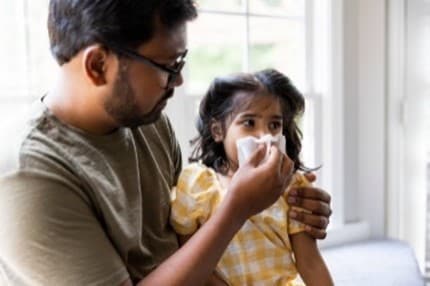Key points
- Most rhinovirus infections are mild, but they can cause serious illness in higher-risk populations.
- There is no vaccine, treatment, or medicine to prevent or cure illness caused by rhinoviruses.
- You can take steps to reduce your risk of getting infected with rhinoviruses and reduce the risk of their spread.

Overview
Rhinoviruses are the most frequent cause of the common cold and are a common viral trigger for asthma attacks. Most rhinovirus infections cause no symptoms or mild symptoms. They can also cause severe illness, especially if you have a weakened immune system, asthma, or another underlying medical condition. There are different rhinovirus types. Rhinoviruses are part of the same virus group as non-polio enteroviruses and have some similar properties to enterovirus D68. Rhinoviruses usually spread year-round, but activity tends to rise in early fall and spring.
There are no immunizations to prevent rhinovirus infection. However, there are vaccines for other respiratory viruses that can cause severe outcomes in some people. For adults and children 6 months and older, CDC recommends getting a current COVID-19 and flu vaccine. CDC also recommends RSV (respiratory syncytial virus) immunizations to protect infants. Adults ages 60 years and older should talk to their healthcare provider if an RSV vaccine is right for them.
Signs and symptoms
You may have no signs or symptoms when you are infected with a rhinovirus. If you do develop symptoms, they often last less than 7 days but can last up to 2 weeks. Your symptoms can be like those of other respiratory infections. They are more likely to turn serious for groups at increased risk for severe illness.
Common signs and symptoms include:
- Runny nose or nasal congestion
- Cough
- Sneezing
- Sore throat
- Headache
- Mild body aches
- Fever
More severe illness is less common but can include:
- Asthma attack and reactive airway disease (wheezing, difficulty breathing)
- Middle ear infections (infection behind the ear drum)
- Sinus infections
- Bronchiolitis (infection of the small airways)
- Bronchitis (infection of the large airways)
- Pneumonia (infection of the lungs)
Learn about managing your symptoms and when to seek medical care.
Prevention
You can take steps to reduce your risk of getting rhinoviruses and reduce the risk of spread if you get sick. Learn about:
Testing
Healthcare providers typically do not test for rhinovirus infection. In people with severe illness, they may order testing for rhinovirus or can test as part of a panel that can detect both viruses and bacteria. Some people with cold symptoms may be tested for COVID-19 or flu. There are treatments for COVID-19 or flu that can reduce the risk of severe disease.
